Horn Book reviews of Caldecott Medal winners, 1940-1949
1940
INGRI AND EDGAR PARIN D'AULAIRE, Author-Illustrators
Abraham Lincoln (Doubleday)
"Deep in the wilderness down in Kentucky there stood a cabin of roughly hewn logs.
 INGRI AND EDGAR PARIN D'AULAIRE, Author-Illustrators
INGRI AND EDGAR PARIN D'AULAIRE, Author-IllustratorsAbraham Lincoln (Doubleday)
"Deep in the wilderness down in Kentucky there stood a cabin of roughly hewn logs. It was a poor little cabin of only one room. But the flames flickered gaily on the hearth....In this cabin lived a man named Thomas Lincoln with his wife and his little daughter, Sally. And here it was that his son, Abraham Lincoln, first saw the world on a Sunday morning (in February). It wasn't much of a house in which he was born, but it was just as good as most people had in Kentucky in 1809." A young assistant in the children's room of a large city branch said when she had finished looking at it, "How the refugee children will love this book!" The d'Aulaires have told the story of Lincoln well and their pictures are bound to interest children and to be interesting and arresting to grown-ups.
reviewed in the May 1939 issue of The Horn Book Magazine
1941
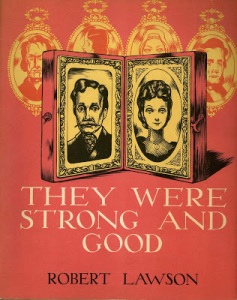 ROBERT LAWSON, Author-Illustrator
ROBERT LAWSON, Author-IllustratorThey Were Strong and Good (Viking)
A country made up as is ours of many different racial strains may well take pains to see that its children are conscious of their heritage. Robert Lawson has made an unusual contribution to such an objective in this boylike record of his own ancestors. His fine line drawings accompanied by short, straightforward text give a picture of these forebears who are a pride to him, not because of wealth or position but because of character. "They were strong and good." The touch is a light one — you can trust Robert Lawson to bring his glinting humor into play — but none the less is the book a bit of social history out of the family album.
reviewed in the November 1940 issue of The Horn Book Magazine
1942
 ROBERT MCCLOSKEY, Author-Illustrator
ROBERT MCCLOSKEY, Author-IllustratorMake Way for Ducklings (Viking)
The Boston Public Garden has never appeared in more attractive guise than in this engaging book. The story of the family of ducks, raised on the Charles River and brought back to the pond in the Garden, through the traffic of city streets by its anxious mother is founded on fact as many Bostonians can testify. Robert McCloskey's unusual and stunning pictures will long be a delight for their fun as well as their spirit of place.
reviewed in the November 1941 issue of The Horn Book Magazine
1943
 VIRGINIA LEE BURTON, Author-Illustrator
VIRGINIA LEE BURTON, Author-IllustratorThe Little House (Houghton)
In the most fascinating picture book of the season, Virginia Lee Burton tells the story of a Little house which wins its way into the very center of our heart. Stunning pictures in color show the changing scene of summer and winter, as the house watches the sun rise and set, and lights begin to twinkle in the nearby city, until she felt the city grow up around her, step by step. Both city and country children will study these pictures with absorption, for there is much exciting detail in them. Besides the seasonal sports and activities of children who played around the house, there is the panorama of the passers-by, in horse-drawn vehicles at first, and then in every kind of motor car you can think of. The pictures are full of life and movement, of work even more than play. And in the end we have the joy of seeing the little house, now shabby and forlorn, move back into the green and sunny country, where the stars shine over her at night. This is the best of Virginia Lee Burton's books, so far, and we predict for it a long and favored life.
reviewed in the November 1942 issue of The Horn Book Magazine
1944
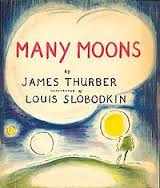 JAMES THURBER
JAMES THURBERMany Moons (Harcourt)
Illustrated by Louis Siobodkin. A charming picture book about an imperious ten-year-old princess who wanted the moon, and what her father did to get it for her. The Lord High Chamberlain, the Royal Wizard, the Royal Mathematician were all called upon in vain, and at last it was the Royal Jester who helped the princess find her own answer to the troublesome demand. Louis Slobodkin's many lovely pictures have an important share in making a distinguished book of this amusing fairy tale — the first book James Thurber has written for children.
reviewed in the September 1943 issue of The Horn Book Magazine
1945
 RACHEL FIELD
RACHEL FIELDPrayer for a Child (Macmillan)
Pictures by Elizabeth Orton Jones. This childlike prayer, written for Hannah, has been printed before, but not in illustrated form, as a book by itself. A realistic, unsentimental picture on each page makes the meaning of the phrases more clear to little children, closer to daily life. This is a choice book for a reverent mother to use at home with a young family.
reviewed in the January 1945 issue of The Horn Book Magazine
1946
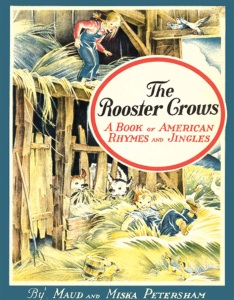 MAUD AND MISKA PETERSHAM, Author-Illustrators
MAUD AND MISKA PETERSHAM, Author-IllustratorsThe Rooster Crows (Macmillan)
"A Book of American Rhymes and Jingles." Counting-out and rope-skipping rhymes bring up visions of generations of American children, in the playground and the street; familiar finger-plays and folk-jingles recall the nursery and the home. "Mother may I go out to swim?" and "Star Light, Star Bright," come back to the memory as easily as "Yankee Doodle." The Petershams have made delightful pictures, in soft harmonious colors, with plenty of humor for these and many other rhymes that American children chant freely. They have made a beautiful book and the publishers have given it clear large type for young readers.
reviewed in the March 1946 issue of The Horn Book Magazine
1947
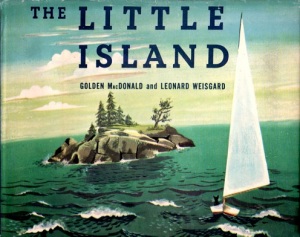 GOLDEN MACDONALD
GOLDEN MACDONALDThe Little Island (Doubleday)
Illustrated by Leonard Weisgard. In some of his most brilliant and exciting pictures Leonard Weisgard shows the changes that the seasons bring to a little island out in the ocean. The rhythmic story tells of the kitten who came ashore from a sailboat and found out the secret of being an island from a wise and talkative fish. A picture book of great charm.
reviewed in the January 1947 issue of The Horn Book Magazine
1948
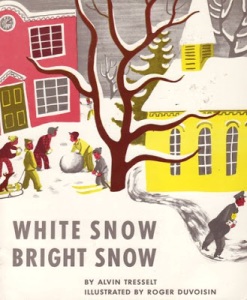 ALVIN TRESSELT
ALVIN TRESSELTWhite Snow Bright Snow (Lothrop)
Illustrated by Roger Duvoisin. Lovely full-page pictures in color convey the joyous feeling of beauty and wonder and frolic that comes to little children when snowflakes are in the air. The text describes some of the work snow brings to grown-ups.
reviewed in the November 1947 issue of The Horn Book Magazine
1949
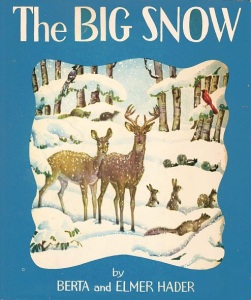 BERTA AND ELMER HADER, Author-Illustrators
BERTA AND ELMER HADER, Author-IllustratorsThe Big Snow (Macmillan)
Lovely pictures in color and in black and white show the different animals of the woods getting ready for winter after they see the wild geese flying south. Here are the cottontails eating plenty of food, the chipmunks busy with their store of nuts; bluejays and cardinals, robins and pheasants, all preparing to stay with the mice and the deer, thinking they are ready for the winter. Then come the snow in all its whiteness and heavy abundance, the need of the wild creatures and the feeding of the birds by two kindly folk in the country.
reviewed in the November 1948 issue of The Horn Book Magazine
These reviews of 1940s Caldecott Medal–winning titles are part of our Caldecott at 75 celebration. Click here for more archival Horn Book material on Elizabeth Orton Jones and Prayer for a Child.
says
says
Add Comment :-
RELATED
RECOMMENDED
ALREADY A SUBSCRIBER? LOG IN
We are currently offering this content for free. Sign up now to activate your personal profile, where you can save articles for future viewing.








